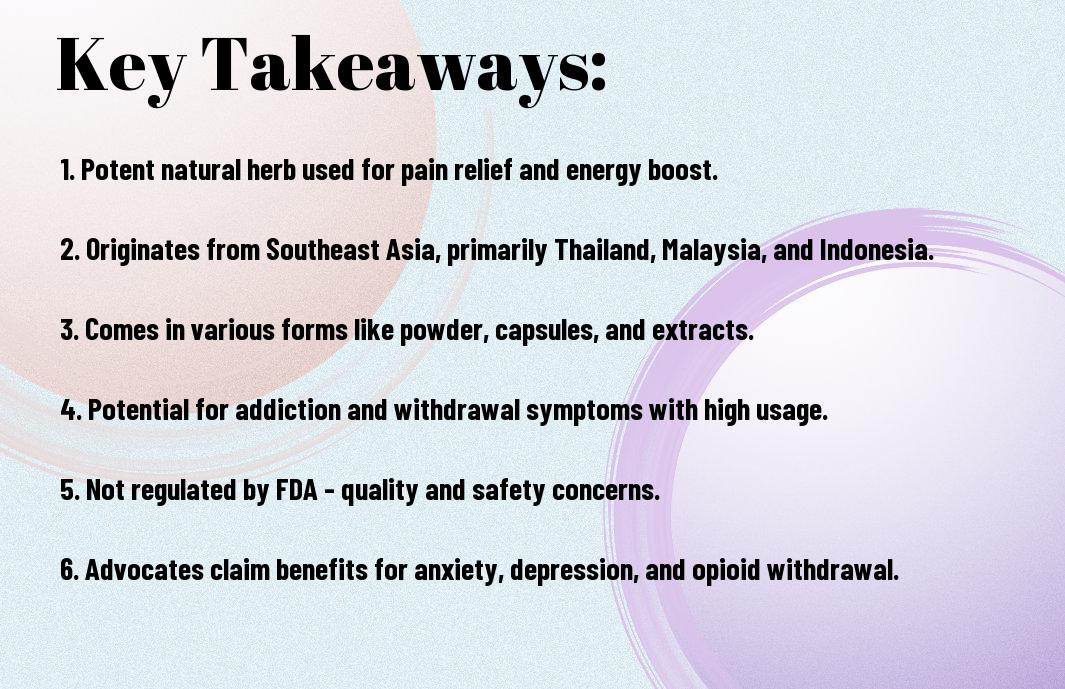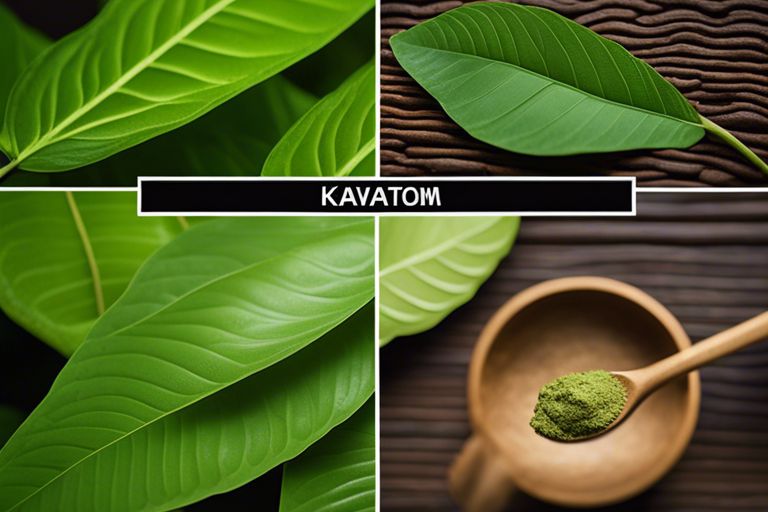With its powerful natural properties and controversial reputation, kratom has been a subject of fascination and debate. Originating from the tropical regions of Southeast Asia, this botanical substance has caught the attention of many for its potential benefits and health risks. To learn more about the origins, uses, and legal status of kratom, examine the Drug Fact Sheet: Kratom provided by the Drug Enforcement Administration.
Key Takeaways:
- Origin: Kratom, often referred to as the “Kratom of the Tropics,” is a plant native to various regions in Southeast Asia, including Thailand, Malaysia, Indonesia, and Papua New Guinea.
- Uses: Traditionally, kratom has been used by the indigenous people of Southeast Asia for its medicinal properties, such as pain relief, energy boost, and mood enhancement. It is also used in cultural and social settings.
- Controversy: Despite its centuries-old traditional use, kratom has been a subject of controversy in recent years due to concerns over its potential addictive properties and safety issues. Regulations and studies continue to evolve to determine the plant’s legal status and health risks.

Habitat and Distribution
Native Regions
For centuries, kratom has been indigenous to Southeast Asia, particularly in countries such as Thailand, Malaysia, Indonesia, and Papua New Guinea. These regions offer the ideal conditions for kratom trees to thrive, including rich, fertile soil and a warm, humid climate.
To its native people, kratom has been a significant part of traditional medicine and cultural practices, with leaves harvested for their various therapeutic effects. The dense rainforests and tropical jungles provide the perfect sanctuary for these trees to grow and flourish.
Tropical Climates
Tropical climates are characterized by high temperatures, heavy rainfall, and abundant sunshine, making them the perfect habitat for kratom trees. These trees require a warm environment to grow and produce their alkaloid-rich leaves, which are harvested for their medicinal properties.
It is in these lush tropical regions that kratom trees reach their full potential, producing potent leaves with a wide range of alkaloids that offer various benefits to those who consume them.
Botanical Characteristics
Now, let’s explore into the fascinating botanical characteristics of the kratom plant. Its unique features make it a standout among the flora of the tropics.
Leaf Structure
Structure: The leaves of the kratom tree are glossy and dark green, with an ovate shape that tapers to a point. They grow in pairs opposite each other along the stem, giving the plant a symmetrical appearance. The veins on the leaves are prominently displayed, creating a distinct pattern that adds to the allure of the plant.
Tree Growth Patterns
The kratom tree is known for its fast growth rate, often reaching heights of up to 80 feet in optimal conditions. It thrives in the humid climates of Southeast Asia, where it can be found in abundance. The tree has a straight trunk and a broad canopy of leaves that provide ample shade in its natural habitat.
Patterns: Kratom trees typically prefer well-draining soil and plenty of sunlight to flourish. They are resilient against pests and diseases, making them relatively low maintenance compared to other tropical plants. The tree’s growth patterns make it an ideal addition to any tropical garden or landscape.
The unique leaf structure and rapid tree growth patterns of the kratom plant make it a captivating botanical specimen worthy of admiration.
Traditional Uses
Folk Medicine
To the people of Southeast Asia, kratom has been a staple in folk medicine for centuries. Traditionally, it has been used to alleviate pain, boost energy levels, and even treat diarrhea. The leaves of the kratom plant are often chewed or brewed into a tea to reap its medicinal benefits.
Cultural Significance
One of the most important aspects of kratom in Southeast Asian cultures is its role in social gatherings. Kratom has been used to enhance social interactions and promote a sense of community. It is often consumed during ceremonies and festivals to bring people together and create a sense of unity.
The people of the tropics hold kratom in high esteem not just for its medicinal properties but also for its cultural significance. It is deeply ingrained in the traditions and beliefs of the region, playing a vital role in spiritual practices and social customs. The leaf represents a connection to nature and a source of communal bonding among various tribes and communities.
Active Compounds
Once again, let’s probe into the intricate world of the active compounds found in the fascinating kratom plant. The compounds present in kratom are responsible for its sought-after effects and have intrigued scientists and enthusiasts alike.
Alkaloids
Compounds such as mitragynine and 7-hydroxymitragynine are the primary alkaloids in kratom responsible for its psychoactive effects. These alkaloids interact with the opioid receptors in the brain, producing effects that can range from pain relief to euphoria, depending on the dosage and individual reactions.
Pharmacological Effects
Pharmacological studies have shown that kratom’s alkaloids not only interact with opioid receptors but also influence other neurotransmitter systems in the brain. This complex interaction accounts for kratom’s diverse effects, including pain relief, mood enhancement, and increased energy.
It is important to note that while kratom can offer various benefits, misuse or overconsumption can lead to unwanted side effects and dependence. Understanding the pharmacological effects of kratom is crucial for safe and responsible use.
Modern Applications
After centuries of traditional use, kratom has found its way into modern applications, with researchers uncovering its potential in various fields of medicine. The following are two main areas where kratom is being used in the modern day:
Pain Management
The use of kratom for pain management has gained popularity in recent years. The leaves of the kratom plant contain alkaloids that interact with the body’s opioid receptors, providing relief from pain. Many individuals find kratom to be effective in alleviating chronic pain conditions such as arthritis, fibromyalgia, and migraines. Its natural origins and effectiveness make it an appealing alternative to prescription pain medications for some users.
Opiate Addiction Treatment
Management
The use of kratom in treating opiate addiction has garnered attention due to its potential to help individuals struggling with opioid dependence. Kratom interacts with the same receptors as opiates but in a milder way, helping to reduce withdrawal symptoms and cravings. While some studies suggest that kratom may be a promising tool in addiction treatment, it is important to approach its use cautiously due to the potential for misuse and addiction. Consulting with a healthcare provider before using kratom for opiate addiction is crucial to ensure safe and effective treatment.
Modern applications of kratom demonstrate its versatility and potential benefits in pain management and addiction treatment. While its natural origins and effectiveness make it an appealing option for some individuals, it is important to exercise caution and seek professional guidance when using kratom for medicinal purposes.

Controversies and Concerns
Not all aspects of kratom are without controversy. There are several concerns surrounding the use of this tropical plant that are worth exploring.
Legal Status
One of the primary concerns surrounding kratom is its legal status in various parts of the world. While some countries and states have banned its use, others have allowed it to be sold and consumed. The legality of kratom can be a point of contention, leading to debates about its potential benefits versus its risks.
Potential Risks and Side Effects
With any natural substance, there are potential risks and side effects to consider. Some individuals may experience negative reactions to kratom, such as nausea, constipation, or even addiction with prolonged use. It is vital to approach the consumption of kratom with caution and awareness of these potential side effects.
Effects: While kratom may offer relief for some individuals struggling with chronic pain or opioid withdrawal symptoms, there is also a real risk of addiction and dependence associated with its use. It is crucial to use kratom responsibly and be aware of the potential for negative side effects.
To wrap up
From above, we have explored the fascinating world of kratom, a tropical plant with a rich history and a myriad of potential benefits. Just like Thoreau immersed himself in the natural world at Walden Pond, we have researchd into the depths of the tropics to uncover the secrets of this plant. As we close this chapter on kratom, let us continue to appreciate and respect the wonders of nature that surround us.
What Are the Benefits of Using Down to Earth Kratom from the Tropics?
Looking for reliable down to earth kratom information? Using Down to Earth Kratom from the tropics can offer a range of benefits, including natural pain relief, increased energy, and improved mood. This organic, plant-based supplement is sourced from the highest quality leaves, providing a pure and potent form of kratom.
What Makes Kratom from the Tropics Unique Compared to Kratom Krates?
Kratom from the tropics stands out due to its unique alkaloid profile and rich biodiversity. On the other hand, kratom Krates may offer a more standardized and consistent product. Understanding the kratom krate differences can help consumers choose the best option for their needs.
FAQ
Q: What is Kratom of the Tropics?
A: Kratom of the Tropics, scientifically known as Mitragyna speciosa, is a tropical evergreen tree native to Southeast Asia. It is a member of the coffee family and has been traditionally used for medicinal and recreational purposes.
Q: What are the common uses of Kratom of the Tropics?
A: Kratom of the Tropics is commonly used for pain relief, relaxation, and as a natural stimulant. It has also been used traditionally for its mood-enhancing properties and to alleviate symptoms of anxiety and depression.
Q: How is Kratom of the Tropics consumed?
A: Kratom of the Tropics can be consumed in various ways, including chewing the leaves, brewing them into tea, or grinding them into a powder and ingesting it. It can also be taken in capsule form for convenience.
Q: What are the potential benefits of using Kratom of the Tropics?
A: Some potential benefits of using Kratom of the Tropics include pain relief, increased energy levels, improved focus and concentration, and enhanced mood. It may also help alleviate symptoms of opioid withdrawal.
Q: Are there any risks or side effects associated with Kratom of the Tropics?
A: While Kratom of the Tropics has been used safely for centuries, it is important to use it responsibly and in moderation. Some potential side effects include nausea, dizziness, constipation, and dependency if used excessively. It is also important to be aware of the legal status of kratom in your region before using it.










